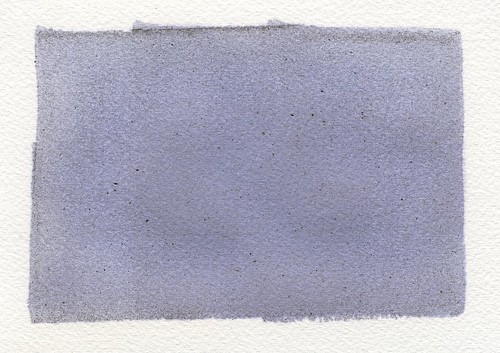Violet is a very easy color to produce for anthotypes since many of the things that make violet are cheap and easy to buy. There are only a few actual dyes, but there are several ways to prepare each one.
 |
| Alkanet with Soda test |
Alkanet: This root is typically used as a textile dye. It interacts with pH values to produce a varying range of blues and purples. I wasn't interested in exploring it for use as a blue dye, so I used high concentrations of the powder and used baking soda to alter the pH of the alkanet-alcohol mixture. Without any soda, alkanet provided a red-violet color. With the soda added, the color shifts to a dull violet, adding a lot of blue. So far, I haven't gotten any results from exposure. I'm expecting the alkanet will take a long time to exposure because the dye is noted as being quite light-fast.
Blackberry: Probably the most flexible source of purple dye for anthotypes, blackberries can be used many different ways. If you just crush the berries and strain the juice without any dilution at all, it provides an intense, Barney-like violet. Diluted, the color is softer but the exposures are shorter. If you boil the blackberries before squeezing them, the color will be darker. If you
filter the boiled blackberry, it reduces the darkness and shifts the color closer to a red-violet. As usual, boiling the dye will slow your exposure times and in general produce less useful results.
There are lots of possibilities and all of them give good results. Generally under a week for your exposures. Also note that blackberries respond well to moisture in the exposure, sometimes creating interesting halos if fresh plants are used and the exposure frame isn't sealed up tight.
There are so many permutations of blackberry, I'll just
link my Flickr dye tests.
 |
| Blueberry, filtered fine |
Blueberry: Now blueberries are right and pretty, but not the best dye. Don't try to boil the blueberries, you'll destroy all the pigment. Boiled blueberry dye produces almost nothing at all. Just straight puree is best; don't dilute the mixture with alcohol. If you rough-filter the puree with cheesecloth or a strainer, you'll get a dark blue-violet. Using a finer filter like a coffee filter will give you a truer purple and a lighter color, with faster exposure times. Overall, blueberry is pretty fast. Expect under a week in strong light to give good exposures. The field will fade to a bluish-brown.


No comments:
Post a Comment